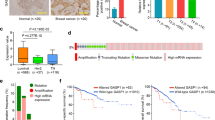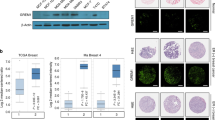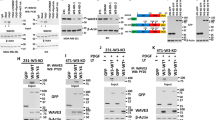Abstract
The dual-function phosphatase and tensin homolog deleted on chromosome 10 (PTEN) is the second most frequently mutated gene in human cancers. PTEN counteracts the functions of many growth factors, the most prevalent of which is insulin-like growth factor II (IGF-II). PTEN expression is stimulated by IGF-II forming a feedback loop. Investigating IGF-binding protein (IGFBP) modulation of IGF-II actions on MCF-7 breast cancer cells, we found that IGFBP-2 also regulates PTEN. The MCF-7 cells were not responsive to high doses of IGF-II due to induction of PTEN, which was not observed with an IGF-II-analog that does not bind to IGFBPs or in the presence of an inhibitor that prevents IGFs associating with IGFBPs. These cells predominantly produce IGFBP-2: blocking IGFBP-2 with a specific antibody, or preventing IGFBP-2 binding to integrins, restored the induction of PTEN and the cells were non-responsive to high doses of the IGF-II-analog. Our findings indicate that breast cancer cells do not respond to high doses of IGF-II due to induction of PTEN, but IGFBP-2, when free from IGF-II can suppress PTEN. Levels of IGFBP-2 are elevated frequently in human tumors: its ability to regulate PTEN could have important implications in relation to therapeutic strategies targeting growth factor pathways.
This is a preview of subscription content, access via your institution
Access options
Subscribe to this journal
Receive 50 print issues and online access
$259.00 per year
only $5.18 per issue
Buy this article
- Purchase on Springer Link
- Instant access to full article PDF
Prices may be subject to local taxes which are calculated during checkout




Similar content being viewed by others
References
Busund LT, Richardsen E, Busund R, Ukkonen T, Bjornsen T, Busch C et al. (2005). Significant expression of IGFBP2 in breast cancer compared with benign lesions. J Clin Pathol 58: 361–366.
Chen Z, Trotman LC, Shaffer D, Lin HK, Dotan ZA, Niki M et al. (2005). Crucial role of p53-dependent cellular senescence in suppression of Pten-deficient tumorigenesis. Nature 436: 725–730.
Clark AS, West K, Streicher S, Dennis PA . (2002). Constitutive and inducible Akt activity promotes resistance to chemotherapy, trastuzumab, or tamoxifen in breast cancer cells. Mol Cancer Ther 1: 707–717.
Clark MA, Perks CM, Winters ZE, Holly JM . (2005). DNA damage uncouples the mitogenic response to IGF-I in MCF-7 malignant breast cancer cells by switching the roles of PI3 kinase and p21WAF1/Cip1. Int J Cancer 116: 506–513.
Coulson VJ, Wass JA, Abdulla AF, Cotterill AM, Holly JM . (1991). Insulin-like growth factor binding proteins (IGFBPs) in acromegaly. Growth Regul 1: 119–124.
Di Cristofano A, Pandolfi PP . (2000). The multiple roles of PTEN in tumor suppression. Cell 100: 387–390.
Dubois V, Couissi D, Schonne E, Remacle C, Trouet A . (1995). Intracellular levels and secretion of insulin-like-growth-factor-binding proteins in MCF-7/6, MCF-7/AZ and MDA-MB-231 breast cancer cells. Differential modulation by estrogens in serum-free medium. Eur J Biochem 232: 47–53.
Dupont J, Karas M, LeRoith D . (2003). The cyclin-dependent kinase inhibitor p21CIP/WAF is a positive regulator of insulin-like growth factor I-induced cell proliferation in MCF-7 human breast cancer cells. J Biol Chem 278: 37256–37264.
Dupont J, Renou JP, Shani M, Hennighausen L, LeRoith D . (2002). PTEN overexpression suppresses proliferation and differentiation and enhances apoptosis of the mouse mammary epithelium. J Clin Invest 110: 815–825.
Freeman DJ, Li AG, Wei G, Li HH, Kertesz N, Lesche R et al. (2003). PTEN tumor suppressor regulates p53 protein levels and activity through phosphatase-dependent and -independent mechanisms. Cancer Cell 3: 117–130.
Gu J, Tamura M, Yamada KM . (1998). Tumor suppressor PTEN inhibits integrin- and growth factor-mediated mitogen-activated protein (MAP) kinase signaling pathways. J Cell Biol 143: 1375–1383.
Hoeflich A, Reisinger R, Lahm H, Kiess W, Blum WF, Kolb HJ et al. (2001). Insulin-like growth factor-binding protein 2 in tumorigenesis: protector or promoter? Cancer Res 61: 8601–8610.
Hwang PH, Kim SY, Lee JC, Kim SJ, Yi HK, Lee DY . (2005). PTEN/MMAC1 enhances the growth inhibition by anticancer drugs with downregulation of IGF-II expression in gastric cancer cells. Exp Mol Med 37: 391–398.
Kang-Park S, Lee YI . (2003). PTEN modulates insulin-like growth factor II (IGF-II)-mediated signaling; the protein phosphatase activity of PTEN downregulates IGF-II expression in hepatoma cells. FEBS Lett 545: 203–208.
Levitt RJ, Georgescu MM, Pollak M . (2005). PTEN-induction in U251 glioma cells decreases the expression of insulin-like growth factor binding protein-2. Biochem Biophys Res Commun 336: 1056–1061.
Li Y, Podsypanina K, Liu X, Crane A, Tan LK, Parsons R et al. (2001). Deficiency of Pten accelerates mammary oncogenesis in MMTV-Wnt-1 transgenic mice. BMC Mol Biol 2: 2.
Liu XJ, Xie Q, Zhu YF, Chen C, Ling N . (2001). Identification of a nonpeptide ligand that releases bioactive insulin-like growth factor-I from its binding protein complex. J Biol Chem 276: 32419–32422.
Maile LA, Gill ZP, Perks CM, Holly JM . (1999). The role of cell surface attachment and proteolysis in the insulin-like growth factor (IGF)-independent effects of IGF-binding protein-3 on apoptosis in breast epithelial cells. Endocrinology 140: 4040–4045.
McCaig C, Perks CM, Holly JM . (2002). Intrinsic actions of IGFBP-3 and IGFBP-5 on Hs578 T breast cancer epithelial cells: inhibition or accentuation of attachment and survival is dependent upon the presence of fibronectin. J Cell Sci 115 (Part 22): 4293–4303.
Moorehead RA, Hojilla CV, De Belle I, Wood GA, Fata JE, Adamson ED et al. (2003). Insulin-like growth factor-II regulates PTEN expression in the mammary gland. J Biol Chem 278: 50422–50427.
Nagata Y, Lan KH, Zhou X, Tan M, Esteva FJ, Sahin AA et al. (2004). PTEN activation contributes to tumor inhibition by trastuzumab, and loss of PTEN predicts trastuzumab resistance in patients. Cancer Cell 6: 117–127.
Schmid AC, Byrne RD, Vilar R, Woscholski R . (2004). Bisperoxovanadium compounds are potent PTEN inhibitors. FEBS Lett 566: 35–38.
Schutt BS, Langkamp M, Rauschnabel U, Ranke MB, Elmlinger MW . (2004). Integrin-mediated action of insulin-like growth factor binding protein-2 in tumor cells. J Mol Endocrinol 32: 859–868.
Sherr CJ, Roberts JM . (1999). CDK inhibitors: positive and negative regulators of G1-phase progression. Genes Dev 13: 1501–1512.
Stambolic V, MacPherson D, Sas D, Lin Y, Snow B, Jang Y et al. (2001). Regulation of PTEN transcription by p53. Mol Cell 8: 317–325.
Stambolic V, Suzuki A, de la Pompa JL, Brothers GM, Mirtsos C, Sasaki T et al. (1998). Negative regulation of PKB/Akt-dependent cell survival by the tumor suppressor PTEN. Cell 95: 29–39.
Stokoe D, Costello JF . (2005). Phosphatase and tensin homologue growth suppression without phosphatase. Proc Natl Acad Sci USA 102: 2677–2678.
Trotman LC, Niki M, Dotan ZA, Koutcher JA, Di Cristofano A, Xiao A et al. (2003). Pten dose dictates cancer progression in the prostate. PLoS Biol 1: E59.
Virolle T, Adamson ED, Baron V, Birle D, Mercola D, Mustelin T et al. (2001). The Egr-1 transcription factor directly activates PTEN during irradiation-induced signalling. Nat Cell Biol 3: 1124–1128.
Weng LP, Brown JL, Baker KM, Ostrowski MC, Eng C . (2002). PTEN blocks insulin-mediated ETS-2 phosphorylation through MAP kinase, independently of the phosphoinositide 3-kinase pathway. Hum Mol Genet 11: 1687–1696.
White ES, Thannickal VJ, Carskadon SL, Dickie EG, Livant DL, Markwart S et al. (2003). Integrin alpha4beta1 regulates migration across basement membranes by lung fibroblasts: a role for phosphatase and tensin homologue deleted on chromosome 10. Am J Respir Crit Care Med 168: 436–442.
Wu RC, Li X, Schonthal AH . (2000). Transcriptional activation of p21WAF1 by PTEN/MMAC1 tumor suppressor. Mol Cell Biochem 203: 59–71.
Acknowledgements
We thank the Breast Cancer Campaign for supporting this work.
Author information
Authors and Affiliations
Corresponding author
Rights and permissions
About this article
Cite this article
Perks, C., Vernon, E., Rosendahl, A. et al. IGF-II and IGFBP-2 differentially regulate PTEN in human breast cancer cells. Oncogene 26, 5966–5972 (2007). https://doi.org/10.1038/sj.onc.1210397
Received:
Revised:
Accepted:
Published:
Issue Date:
DOI: https://doi.org/10.1038/sj.onc.1210397
Keywords
This article is cited by
-
Quantification of putative ovarian cancer serum protein biomarkers using a multiplexed targeted mass spectrometry assay
Clinical Proteomics (2024)
-
Targeting the HIF-1α-IGFBP2 axis therapeutically reduces IGF1-AKT signaling and blocks the growth and metastasis of relapsed anaplastic Wilms tumor
Oncogene (2021)
-
IGFBP2: integrative hub of developmental and oncogenic signaling network
Oncogene (2020)
-
Relationship of circulating insulin-like growth factor-I and binding proteins 1–7 with mammographic density among women undergoing image-guided diagnostic breast biopsy
Breast Cancer Research (2019)
-
IGFBP-2 and −5: important regulators of normal and neoplastic mammary gland physiology
Journal of Cell Communication and Signaling (2015)



